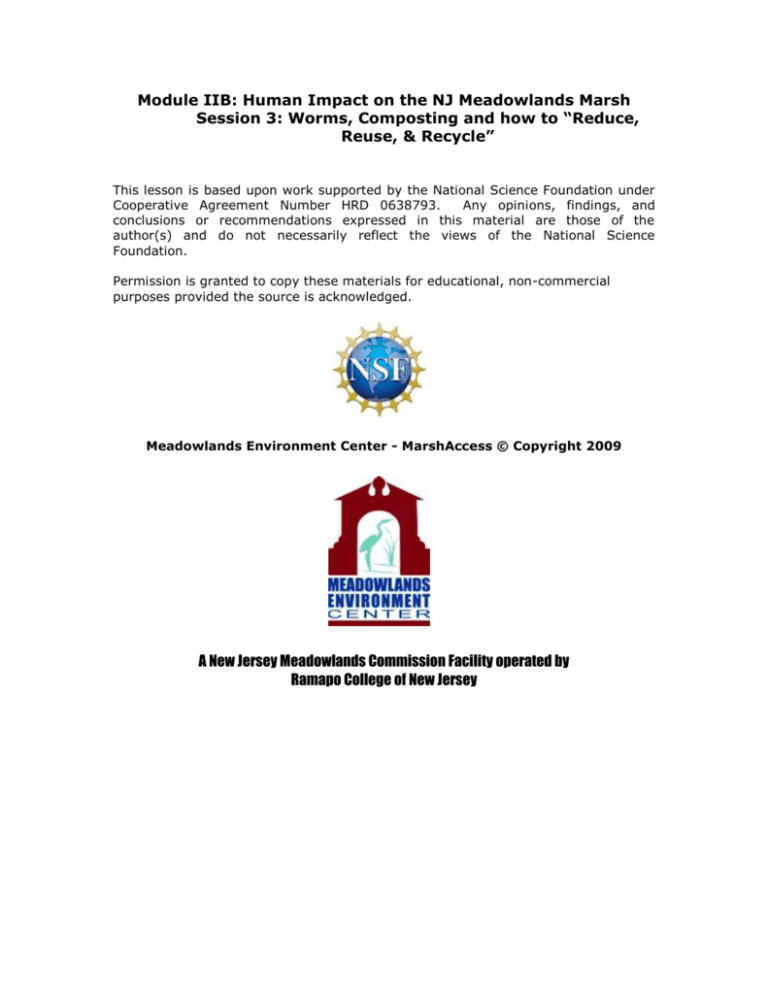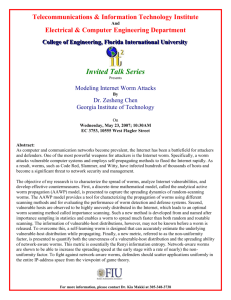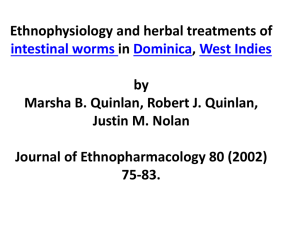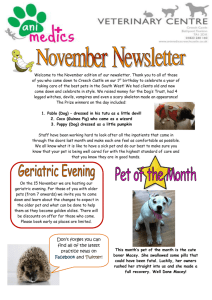Worms, Composting and how to “Reduce, Reuse, & Recycle”
advertisement

Module IIB: Human Impact on the NJ Meadowlands Marsh Session 3: Worms, Composting and how to “Reduce, Reuse, & Recycle” This lesson is based upon work supported by the National Science Foundation under Cooperative Agreement Number HRD 0638793. Any opinions, findings, and conclusions or recommendations expressed in this material are those of the author(s) and do not necessarily reflect the views of the National Science Foundation. Permission is granted to copy these materials for educational, non-commercial purposes provided the source is acknowledged. Meadowlands Environment Center - MarshAccess © Copyright 2009 A New Jersey Meadowlands Commission Facility operated by Ramapo College of New Jersey Module IIB: Human Impact on the NJ Meadowlands Marsh Session 3: Worms, Composting and how to “Reduce, Reuse, and Recycle” Science Content Anatomy of Eisenia fetida (red worm) Process of Decomposition Worms as composting machines Waste stream Importance of worms to the environment Science Tools Microscopes Forceps Low tech magnification devices Ken-a-Vision Meadowlands Content Human Impact mitigated through composting Reducing landfills through composting can also change the region Documentation Journal sheets - Label Worm Anatomy Worm drawings Instructional Objectives: Participants will learn / be able to: Understand the waste stream and the percentage of common materials within it Describe the process of decomposition; Define and name common decomposers; Describe the benefits of composting (reduction of waste stream, production of fertilizer, nutrient recycling). Identify common parts of worm anatomy using real worms and soft worm model Recognize how the worm anatomy creates compost Introduction (20 minutes) Hold the containers over students’ heads and ask them to feel the contents. Ask them what it feels like. Pouring both tub contents onto the large tray for visibility, explain that the contents of tub 2 are the same as that of tub 1, except they have been through the “world’s smallest recycling center.” Introduce the students to a solid waste cycle, using a tree as the focus. Draw a tree, a fallen log, and soil with small things living in the soil; connect the pictures with arrows (creating a “recycle” triangle of the drawings). Show the laminated pie chart, emphasizing how much waste is “food” and “yard” (combined about 25%). Introduce the concept of humans as stewards or caretakers of the planet, and how we need to reduce how much waste we generate. Introduce the “world’s smallest recycling center,” a.k.a. the worm and a working compost bin! Explain that our composting worms are called ‘red worms’ and are different than the earthworms that they may find in a garden or park. It will slowly dawn on the students what their hands were just in! If they think it’s disgusting, explain that soil is made up mostly of this compost and that, if it weren’t for worms, there would be no soil, no plants, etc. Some worm facts: In a healthy pasture, the worms can add two inches of healthy, nutrient-rich soil every year. Materials: -Solid Waste pie chart -2 containers, one to hold natural waste and the other to hold worm castings. -2 trays one to display each material within the containers. -Active worm compost bin - Worm models Universal Instructional Design (UID) – Educator will review, through a PowerPoint, how worms are important to the waste stream and to the environment. Educator reads and describes images on slides. PowerPoint color contrast, font and size meet accessibility standards; white space, no more than 6 lines of text, no more than 6 words per line, images have alternate text tags. Worm models (soft fabric and hard resin) used to enhance verbal instruction. A copy of PowerPoint is available in color (1 or 2 slides per page) in a 3-ring binder. A sound field system/assistive listening devices for those with hearing impairments or attention difficulties will be provided. Activity- Worm Anatomy and Composting (45 minutes) Give each participant a spoonful of compost and worms in a Petri dish. Ask students to examine the worms using the hand lenses and the microscopes. Warn students to be gentle to the worms and not to leave them in the heat or light too long. Fill in the Worms Eat My Garbage page in the journal. Have a drawing of the worm’s anatomy on the board and label it as each part is discussed. Discuss how the worm “sees”, breathes, and eats. Ask the students who has a male worm? Who has a female? How can you tell? Tell them nobody has a male worm, and nobody has a female worm; all of these worms are hermaphrodites (from the Greek gods Hermes and Aphrodite). Review the journal. Return the discussion to the topic of recycling, and how much waste can be removed from the waste stream if everyone composted (about 25-30%) and the value of returning nutrients to the soil instead of entombing them in a landfill. Materials (1/participant): -Microscopes -Forceps -Petri dishes and covers -Pencils and journal pages Universal Instructional Design – Educator elicits responses. Educator verbally explains and physically demonstrates how to use a microscope and the appropriate way to handle the worms without causing harm. Worm models (soft fabric and hard resin) used to enhance verbal instruction. A sound field system/assistive listening devices for those with hearing impairments or attention difficulties will be used. Program Modifications/ Adaptations Following are specific accommodations/adaptations and strategies found effective, and currently in use or being tested for use by specific disability groups in this program module. Cognitive Disabilities Content –To simplify content and place emphasis on the worm observation activity, participants will answer less journal questions. Learning Environment – Extra staff assistance. More time to learn how to use the scopes; shortened program Materials –Participants have the option of using a tongue depressor or forceps to manipulate the worm. Communication boards with text and images serving as memory prompts, or for use in non-verbal response. Equipment/Assistive Technologies – Binocular microscopes are easier to use than other models. Low-tech magnification devices. Ken-a-Vision, CCTV, and ProScope for group viewing. Large screen monitor. Teaching Strategies – Use simple vocabulary; frequently repeat concepts; speak slowly; ask multiple choice questions (only giving them two options); verbal or kinesthetic participation in activities. Physically demonstrate how to do activities. Break down information into small pieces. When necessary, demonstrate, hand-over-hand, how to do an activity. Have participants work with a partner. Group subdivided into smaller groups (4 at a table, one educator per table). If possible, train partner staff first to enable them to better assist their participants. Mobility Disabilities Learning Environment – more time to learn how to use the scopes; shortened program. Extra staff assistance. Materials - Larger chart page size attached to large clip board; large print and peel off labels with corresponding words and pictures. Large worms for viewing (bait worms). Equipment/Assistive Technologies – Educator / assistant aids in journal completion. Lap trays or height adjustable tables can be used for wheelchair users or those with physical access issues. Laptop computer for recording observations using alternative input devices. Communication boards with text and images serving as memory prompts, or for use in non-verbal response. Teaching Strategies – open-ended questions, some multiple choice questions, extra time to respond either verbally or with personal communication device; additional time to execute activities. Participants subdivided into small groups (4 at a table) with one educator and an assistant. Flexible approach to all activities (e.g. eliminating activities or re-calculating time spent on each portion of the program; developing new methods for accomplishing physical tasks based on trial and error, participant or chaperone suggestion) Blind and Low Vision Content – High level, age appropriate content. Learning Environment – Shorter walking route to field sites; more time to move from site to site; lengthened program; alternate indoor classroom. Models of worms. Materials - Journal and other documents enlarged to Verdana 20 pt.; documents converted to Braille; PowerPoint offered in a binder, with one slide per page; PowerPoint available in electronic, accessible formats for personal viewing following the scheduled program. Equipment/Assistive Technologies - Tape recorders to verbally record data. Braille embosser and Braille translation software for converting text documents into Braille. Laptop computer for recording observations using alternative input devices. Teaching Strategies - Educator reads what is on each PowerPoint slide, and verbally describes relevant pictures in detail. Hand-on-hand assistance with activities. Verbal description of items being used, including color, shape, physical characteristics, etc. Deafness and Hearing Loss Content – High level, age appropriate content. Learning Environment – Seating and activities arranged to accommodate need for lip reading and sign language presentation. Materials/equipment – Sound field and assistive listening devices. Written and visual step by step instructions for all procedures and activities. Journals with peel off picture and/or text labels for recording information. Text and visual instructions for all activities displayed at each work station. Communication boards with text and images serving as memory prompts, or for use in non-verbal response. Teaching Strategies – Use of interpreter(s) that have been provided with key vocabulary beforehand. Educator speaks slowly and clearly, to accommodate interpreters and those who lip read; educator stands in a central, front of room location so all participants who lip-read can clearly see the face of the educator. Educator physically demonstrates how to use various tools/equipment, waiting between steps for interpreter to complete translation, and to wait for any questions. Participants break up into small groups (4 or less) during activity, with assistant working with each group, and interpreters moving from group to group as needed. Educator refers to simplified and standard text and visual step-by-step instructions. Age-Related Limitations Note: All materials, equipment, assistive technologies, and teaching strategies described above would be implemented based on the functional ability /disability (cognition, mobility, hearing, vision) of the participant. Content: High level, age appropriate content, closely related to expected life experiences of participants. Learning Environment – Shorter walking route to field site; more time to move from site to site; shortened program. Materials - High level, high interest journals with large font, visually organized with a great deal of white space separating text, images, answer boxes. Communication boards with text and images serving as memory prompts, or for use in non-verbal response. Equipment/Assistive Technologies – Sound field and assistive listening devices. Teaching Strategies – slower pace of instruction (especially with those individuals with aphasia), allowing extended time to ask and answer questions. Use of whiteboard to write down key concepts during lecture/discussion phase of program. Relate science content to life experiences. Participants break up into small groups (4 or less) during activity to encourage interaction and participation.







